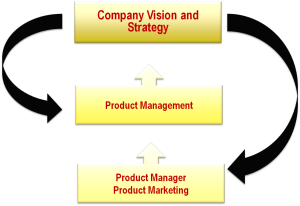In my post, Essential Pieces for Strategic Product Leadership, I outlined four areas that are paramount for product leaders. First on my list was Product Vision and I’ll focus on that topic for this post. Before I dive in, I want to clarify that when I discuss product leadership, I’m not talking about a title, but contributive role, a mindset and actions that influence the business. This traverses all roles in the discipline of product management.
Joining a new company some years ago, I had the opportunity of sitting with the CEO. As the new senior product leader, I wanted to better understand the company’s vision and what was most important to him.
One of the first questions I asked was, “What’s your personal vision for the company?” His response was straightforward and to the point. “I want to be a billion dollar company by 2010.”
I sat there for a few seconds thinking about his question. At the time, the company was about one-fifth the size. Before I could ask any clarifying questions, he asked, “What would the product vision look like to support this?” It took me a few seconds to gather my thoughts and I said, “A lot more than I envisioned this morning.”
Over time, I realized that the vision of the company was more than a magical revenue number and a date in the future. It was a living entity owned by several of the senior management team and I was fully engaged in the process.
This example isn’t unlike many organizations. The words mission, vision, strategy and goals are thrown around, confused and co-mingled. While this post won’t delve into this, I will follow on with another post to discuss and demystify the terminology and process.
In a recent post entitled, “Why Should Anyone Trust Your Vision” by Harvard’s John Kotter, he shares; “Almost all managers have been brought up in a world where small-numbers decide, large-numbers execute (after the large-numbers are “sold,” which is almost impossible if the small-numbers are not trusted). People continue to think and act this way, often unconsciously.”
How can product leaders influence product vision in conventional decide – execute organizations?
John explains, “The conventional decide-execute model handles large changes very poorly. Let’s just say that success comes from a lot more people getting involved in the decision-making process.”
I believe a key part of the decision-making process comes from the bottom up, and every product leader has an opportunity to influence in some capacity.
Influence from the Bottom Up – product leaders who consistently build, communicate and collaborate with market data, current trends, competitive knowledge, customer feedback and data points developed from daily activities have a higher probability of impacting their organizations product vision.
Why? When you have a strong understanding of market problems, know buyers and users, and can articulate stories in common terms everyone including users, sales and executives understand, you create a valued relationship.
CEOs and executives seek trusted advisors and reliable sources. If those don’t exist, others will be found and used. Don’t ever under-estimate the power of bottom up influence and the value your information and knowledge provides.
Influence in the Middle happens when product management teams unite to collaborate for the common good of products or services. This type of collaboration fosters thought leadership and alignment. While reading Get Your Ducks in a Row, Jennifer Doctor shared, “While having independent thought and avoiding group think, all personnel in the organization need to be following the same vision and product road map.”
In his post 5 Steps to Building a Great Product Management Team, Saeed Khan shares, “Too often technology product management is viewed as the requirements collector, or keeper of the product roadmap, or an adjunct to Engineering. But all of these sell short the value and impact Product Management can have on a business.”
“Thought leaders embrace and extend the information found in their daily lives that reveal directions, trends and future states” said Steve Johnson of Pragmatic Marketing.
Executives often are looking for the direction, trends and future states that create or refine vision. As a team do you create, communicate and provide measurable value to the executive team? If not, get the team together and discuss what’s missing and then create an action plan of how you’ll begin to correct this in the next 30 days. Use each others talent, skills and experiences to reconnect with the executive team.
Guiding from the Top – is easiest when you’re sitting at a vantage point that’s across the table from the executives. While a seat at the executive table is desirable for product management, it may not be feasible in your organization. While you may not have a permanent seat, having an open invitation to join them is a great start.
How can product leaders gain access to the executive table? It all starts with TRUST.
Trust, the Foundation – A CEO friend of mine recently shared, “The single largest excise tax in organizations is TRUST. However, there’s a vacuum of trust in many organizations. At the end of the day, those willing to fill that vacuum make my decisions more tolerable.”
Michael Hopkin shares in his post Three Winning Words, “The word trust has bi-direction meaning and only works when flowing both ways: you have to depend on other people to do what they say they will do; and you have to work, act and believe so that others will confide in and depend on you. People who live and behave in such a way that others can confide in them understand the importance of trust.”
If trust is established between product leaders and executive management, a Vision of Influence will emerge. From the bottom up, product leaders can infuse direction, trends and insight that influence vision.
I’ve seen this vision of influence firsthand and its great to hear executives say, “We don’t do anything without product management’s endorsement. They own product vision.”
Leading product vision and creating influence takes time, patience and focus. It requires an organization where each person is a product leader. In a future post, I’ll discuss structure, alignment and how to build product leaders into your organization.
Feel free to post any comments and retweet the post on Twitter. If you’d like to connect via email, I can be reached at jholland(at)missioncreekpartners(dot)com.
Jim


